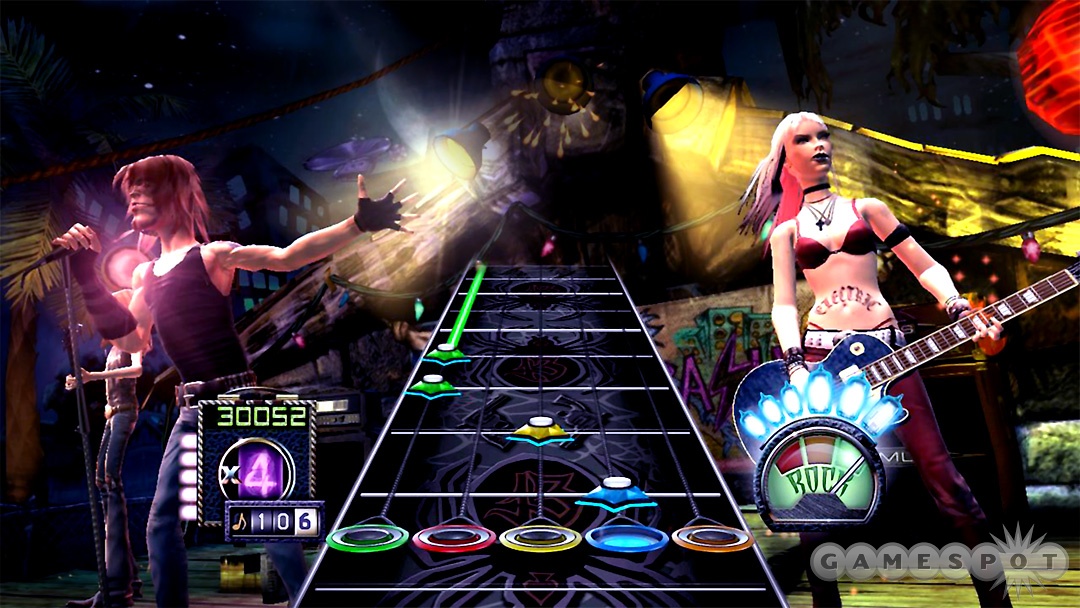Guitar Hero III: Legends of Rock Hands-On
We rock out to some legendary rock-and-roll songs as we try out the upcoming Windows version of the popular console franchise.
The Guitar Hero phenomenon has swept the consoles over the past couple of years, and it will finally arrive on the PC in November in the form of Guitar Hero III: Legends of Rock. Guitar Hero's popularity is in large part due to its addictive gameplay, which lets you feel like a rock-and-roll god with your plastic guitar controller in your hand as you attempt to hit the notes to many an iconic song. Although the PC version of Guitar Hero III is essentially a port of the upcoming console versions, it will also include some alternate control methods designed for the PC.

If you're reading this, then we'll assume you haven't played a Guitar Hero game on console before and are completely new to the franchise. The premise behind Guitar Hero is simple. You hold in your hands a special controller, which is shaped just like a real guitar. It has five brightly colored buttons on the fret board, and a strum bar that can move up and down to replicate the action of strumming strings. While a song plays, the fret board on the screen displays the buttons you have to hit to match the notes in time. At the easy difficulty level, a single song might contain a couple hundred notes. At the medium difficulty level, that same song might contain up to 500 or 600 notes. The difficulty ramp ups considerably when you hit the hard and expert levels, the latter of which might contain as many as 2,000 notes.
Scattered throughout the song are sequences of notes outlined by stars. Hitting all of these notes fills up your star-power meter. When you have enough star power, you can activate it by lifting your guitar into a vertical position (a sensor in the guitar detects the move), and when star power is active you get a bonus to your score. There's a multistep tutorial that introduces you to the basics of the game, from hitting notes to using star power as well as the whammy bar, a lever that's attached to the guitar to let you change the pitch.
The PC game will feature several control methods. Most players will play the game using the included X-plorer guitar controller, which is the exact same model used for the Xbox 360 game, right down to the Xbox Guide button. (The game and controller bundle will come in around $80, and the game will not be sold separately.) Let's say you want another controller so a friend can play bass guitar while you play lead guitar. Fortunately, any USB guitar controller made for the consoles will also work with the PC game. If a guitar controller is unavailable, or you have only one guitar but want to play with a friend, then the second player can use either the keyboard or the keyboard and mouse in tandem. With the latter, the keyboard is used for the fret buttons, whereas the left mouse button strums down, the right mouse button strums up, the middle mouse button activates star power, and moving the mouse activates the whammy bar. The keyboard-only control scheme is mainly for laptop players, and it's certainly playable, though it's not very comfortable, particularly during a long set of rapid tapping.
In terms of content, the PC game will feature everything in the Xbox 360 game, from which Aspyr is making the ported version. We're told that there will be more than 70 tracks in the game, and we were able to play such classics as Heart's "Barracuda," Pearl Jam's "Even Flow," and The Rolling Stones' "Paint it Black." Some of the songs in the game are original recordings, and the rest are covers. Of course, that brings up the question of downloadable content; the Xbox 360 version of Guitar Hero II features downloadable song packs that you can purchase, so it's a no-brainer that there will be DLC for Guitar Hero III. Aspyr says that it's working on a solution that will keep all the parties happy, and there are a lot of people to satisfy, from Activision, to the artists and the record labels.

Visually, the game looks as good as the Xbox 360 game, provided that you have a high-end PC. Surprisingly, there's a lot more happening onscreen than just the notes on a fret board. You watch as your virtual avatars in the band rock out, backed by plenty of elaborate light effects. Then there's the large virtual audience giving you feedback on how well you're playing. Thankfully, many of the visual options can be tuned down, and the crowd number lowered, to allow for good performance on slower machines. There's even a way to calibrate the audio-lag calibration that might exist on computers with slower processors, which might have trouble keeping up.
It's hard to overstate just how much of a rock-and-roll star you feel like when you're strumming the guitar controller in time with a classic rock ballad. Even if you're missing notes, the action is so fast-paced that you're busy trying to get back in rhythm and rocking again. It's so much fun that you might have to resist wanting to bash the guitar against the floor--a longtime rock tradition--at the end of a great song. This is the perfect example of a game that almost anyone can enjoy. Guitar Hero III will ship next month.
Got a news tip or want to contact us directly? Email news@gamespot.com
Join the conversation